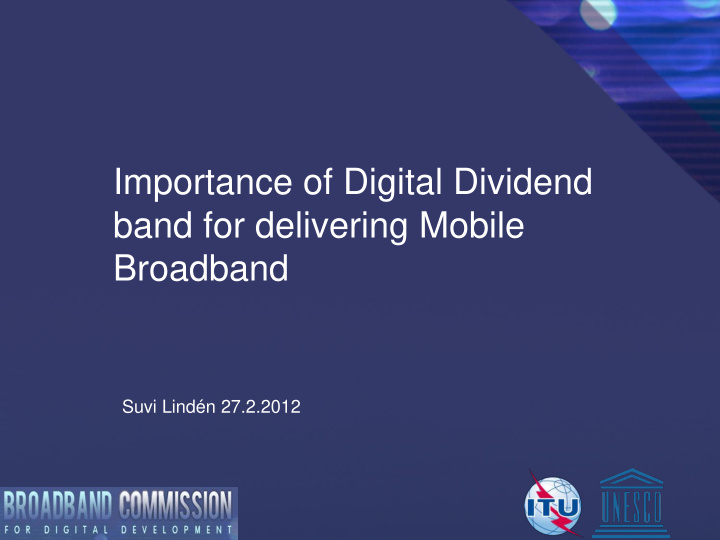



Importance of Digital Dividend band for delivering Mobile Broadband Suvi Lindén 27.2.2012
Broadband: Key economic driver for the next decades
3
What is the digital dividend? Teksti Teksti
How can this dividend be used? 5
Accessing the benefits of the digital dividend 6
WRC -12 1.The sharing issues in the 800 MHz band were successfully resolved
WRC -12 2. the 700 MHz band to the mobile services in Europe, Africa and Middle East, effective by the end of 2015 -> opens the way for worldwide harmonization of both 700MHz and 800 MHz bands for mobile
WRC -12 3. WRC-15 will consider additional spectrum allocations for mobile communication services -> mobile services more affordable for end users and will help ITU towards its mandate of “connecting the world”. 9
Moving forward to 2015 Key Messages from Broadband Leadership Summit • MDGs : Broadband accelerates progress • Access : Ensuring universal access to information and the “right to communicate” • Economy : Broadband is critical infrastructure • Development : Broadband benefits all society • Partnership : Public-private sector cooperation • Policy : National broadband plans • Innovation : Private sector has vital role to play
Target 1: Making broadband policy universal • By 2015, all countries should have a national broadband plan or strategy or include broadband in their Universal Access / Service Definitions Action to enhance broadband access is more likely when there is a national broadband plan or strategy, or when broadband is included in countries’ Universal Access / Service (UAS) definitions
Challenge and targets Target 2: Making broadband affordable • By 2015, entry-level broadband services should be made affordable in developing countries through adequate regulation and market forces (amounting to less than 5% of average monthly income) • In 49 economies in the world – mostly rich-world economies – broadband access in 2010 cost less that 2% of average income • This compares to 32 economies in the world in 2010 where broadband access cost more than half of average national 12 income
Challenge and targets Target 3: Connecting homes to broadband • By 2015, 40% of households in developing countries should have Internet access • In developed countries, more than 2/3 of households already had Internet access at the end of 2010, compared to around 16% of households in the developing world. This is likely to increase significantly by 2015, especially with the rise of mobile Internet • This target includes access via both fixed and mobile networks 13
Target 4: Getting people online • By 2015, Internet user penetration should reach 60% worldwide, 50% in developing countries and 15% in LDCs • At the end of 2010, 30% of the global population was online. Internet penetration in 2010 stood at 21% in the developing world and at just under 5% in the LDCs 14
Recommend
More recommend